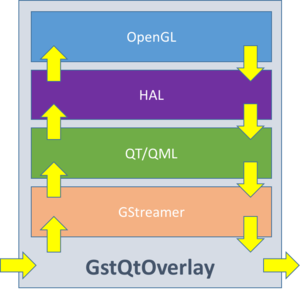GstQtOverlay Architecture
| GStreamer Qt Overlay |
|---|

|
| Overview |
| Getting Started |
| Examples |
| Performance |
| Similar Solutions |
| Troubleshooting |
| FAQ |
| Contact Us |

|

|
GstQtOverlay brings together GStreamer, Qt, and OpenGL to render beautiful graphical components in a video stream taking advantage of the GPU power. GstQtOverlay element's architecture can be viewed in four layers, summarized in Figure 1:

GStreamer

This layer provides the necessary classes to expose GstQtOverlay as a GStreamer element. As such, GstQtOverlay can be linked into any compatible GStreamer pipeline and will participate in the standard pipeline lifecycle. This includes among other, caps and allocator negotiation, and pipeline state changes.
Qt/QML

On top of GStreamer, a Qt-powered class is instantiated in order to manage graphic resources in a decoupled way. Here, the Qt event loop is specially processed in order to have both Glib's and Qt's event sources active. Finally, a QML engine is created to read and render the user's QML file.
OpenGL
 The OpenGL layer will render Qt content into the image data using the GPU's parallel power. The blitting to merge the Qt image onto a video frame is performed into a copy of the frame image so that the integrity of the original data is preserved.
The OpenGL layer will render Qt content into the image data using the GPU's parallel power. The blitting to merge the Qt image onto a video frame is performed into a copy of the frame image so that the integrity of the original data is preserved.
LibInput
Provides user interactivity to GstQtOverlay to intercept the mouse, touchscreen and keyboard events, making UIs powerful and appealing, keeping high-performance without requiring any window manager.
HAL
The Hardware Abstraction Layer (or simply HAL) is a thin layer that acts as an adapter between Qt and OpenGL in order to leverage the platform-specific GPU utilities and maximize performance. This layer is the only one that is hardware dependent and will be conditionally built via configuration parameters. The HAL ensures that data transfers are hardware-accelerated so that there is no performance penalty.


